Diploma 2018: "A Rural Experiment Futuristic studies of Nesbyen - a small mountainous town in Norway" by Sondre Nordhagen Urtegård
Tutors: Andre Fontes (APP), Thomas Wiesner (DAV), Harald Røstvik (sustainability), Anne Sofie H. Bjelland (TTA)
This masterplan project investigate mechanisms that influence many small towns and rural places in Norway. Nesbyen was used as a testbed for the registrations that looks deeper into the history, the current situation, and general development tendencies in Norway. From this I try to understand the need for future development. The objective was to propose an alternative strategy to make Nesbyen a sustainable village for the future. Nesbyen is, as many other places, suffering from what I call “a small place syndrome”. Its effect is depopulation and empty houses.
The focus is mainly on the social relations and mental health, as can be seen as a challenge due to the general social structure in our society and in small places. Terms like identity, community, belonging, and participation is emphasized through the forms of the proposal.
The Small Place Syndrome
Nesbyen used to be the administration center and the place of residence for officials in Hallingdal. Today the town is losing ground to the neighboring municipalities, and strives to attract people. Nesbyen has 60 % more people over 80 years than the average in Norway. The birth rate is dropping, and there is a clear lack of people in their 30’s. The consequences are empty houses, less tax income, bankruptcy, and lower quality of living.
Nesbyen is not the only place that faces this grave future. In fact, many small places struggle with depopulation, homogenous populations, and few people with higher education. In addition, we see an increasing proportion of people who feel lonely. Why do challenges like these occurs in small places? And what kind of counter measures, initiatives and alternatives can help turn things around?
A Social and Ecological Project
Sustainable development is achieved through the right balancing of economical, social and ecological initiatives. I argue that the social part is neglected in Nesbyen and needs greater attention. For a place to grow in a good way, it needs to provide and promote a good social atmosphere. The way we live our everyday lives is of grave importance for our mental wellbeing. That means that we have to take into account how the social- and physical structures that surrounds us, affects our behaviour, and how we meet and interact with one another.
The center of Nesbyen is slowly dying, and everyone seems to agree that something have to change in order for Nesbyen to become a robust community prepared for the future. The goal should be a good place to live, a place to belong, and a place that provides a common identity for the people living there. A society where people can interact and participate.
Mixing it up
One of the problems I have identified in Nesbyen is typical post war zone planning and segregation of programs - Commercial in the center and everything else dispersed around. The different age groups are, to a large extent, kept separated. As a result elderly and young people rarely meet. The same goes for tourists, locals and the large group of cabin owners. By creating meeting places across generations, class and cultures, Nesbyen could grow in to a tolerant and welcoming place.
One way to make people meet, is to stimulate movement. Today the people in Nesbyen is dependent on the car. The distances are not that far in reality, but they feel vast. The walkability of the town is to an extent neglected, and it is not facilitated good enough for pedestrians. The pedestrians should not only get a safe place to move, but also a place that provides a interesting, comfortable and useful walk, separated from the noisy car traffic. The hope is that this can contribute to making the people in Nes use the center more. Today the center is mostly used for commercial activities, but it has the potential to be so much more.
Making connections
I propose to connect the train station more closely to the center. New and improved railway tracks are being planned, which would mean new potensial for developments in Nesbyen. This will reduce the travelling distance to Oslo, and make it not only a more interesting place to live for young people and commuters, but also make it a more interesting place for business. The train will become a more solid competitor to the car for the cabin owners and hikers. Nesbyen should take advantage of this, and make it possible to get to the cabin areas in the mountain by train. This would also generate new needs for transportation and shopping, that the town can benefit from financially.
Another change I propose is densification in strategic points, and focus on new forms of living. Today Nesbyen struggles with a non-sustainable urban sprawl, dominated by the single family house. But different groups of people want and need different kinds of housing. The single family home is not attracting young, unmarried people. There is need for a more flexible housing market, with increased possibilities for renting and owning in the center.
Emphasize the existing
Nesbyen has already got some good qualities that needs to be emphasized. There are two rivers running through Nesbyen, but now they only functions as barriers. And the mountain scenery lie as a beautiful frame around the town, but they need to be closer connected. The town also has a proud and rich cultural heritage worth presenting, but is today hidden behind the big shopping mall.
model perspective: Left: Town Center, Opening programs and defining a new plaza. Top Right: Local center, a visual stop on the line, where young and old got an arena to meet. Down right: a new bridge connection, creating a pedestrian friendly movement through the historical street.

A long term development plan connecting the train station to the center, and to the museum. A new bridge allows for the revitalization of the historical street to the station.
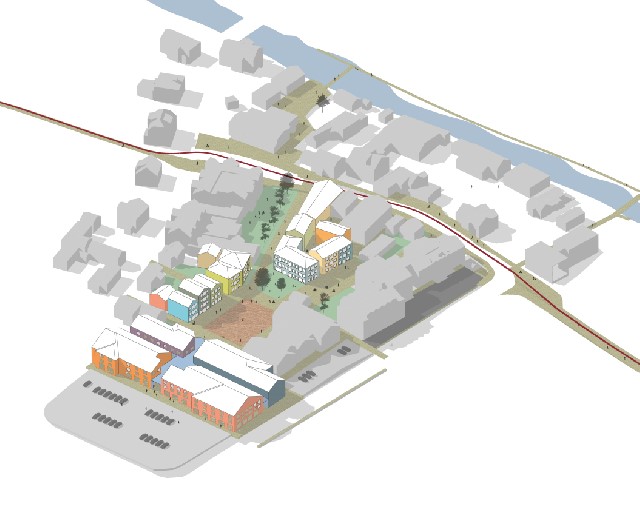
Site 1: Town center. New volum defining meeting places and opening up new paths to the historical street
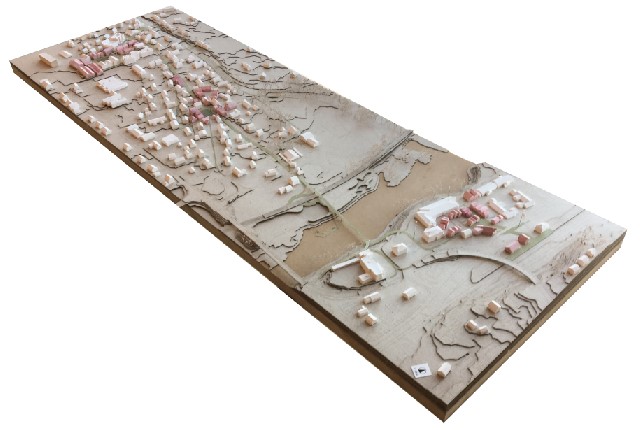
Landscape model showing a new pedestrian friendly connection to the center
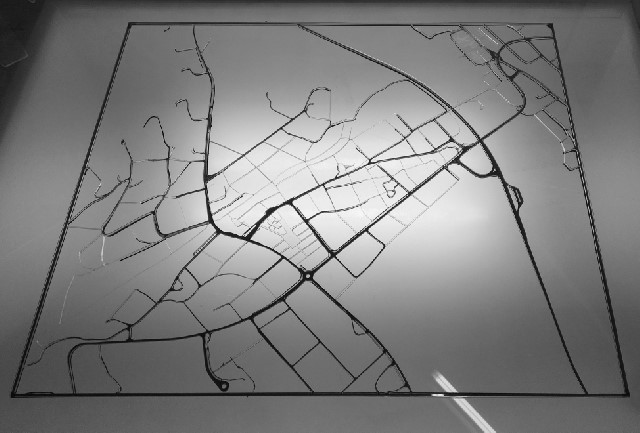
Abstract model of new and old street networks. By completing the grid, and removing the dead ends, a more pedestiran friendly environment occures.
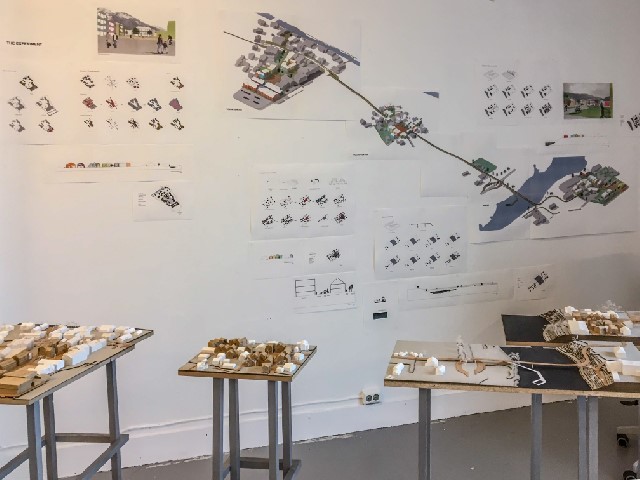
Exhibition
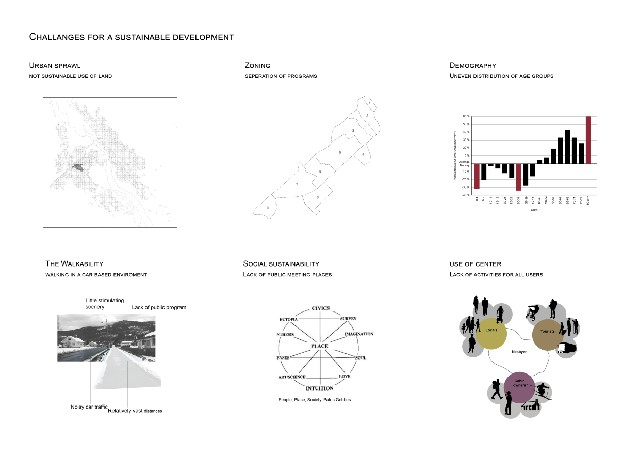
Challanges. Small place syndrome.
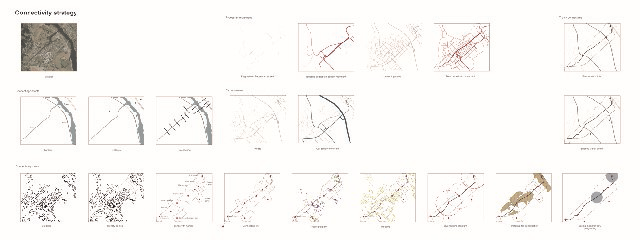
Urban Scheme. Connectivity strategy
